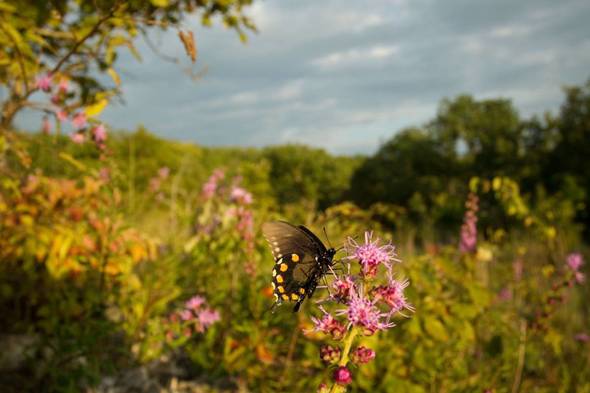
Xplor reconnects kids to nature and helps them find adventure in their own backyard. Free to residents of Missouri.


































Stay in Touch with MDC news, newsletters, events, and manage your subscription

Xplor reconnects kids to nature and helps them find adventure in their own backyard. Free to residents of Missouri.

A monthly publication about conservation in Missouri. Started in 1938, the printed magazine is free to residents of Missouri.


WEST PLAINS, Mo. -- The Missouri Ozarks are special for many reasons, many of which are tied to the land. Native short-leafed pine trees swaying in the wind, steep and beautiful hills and hollows, crystal-clear rivers and our abundant wildlife are all aspects of the Ozarks that we love. Many of our wildlife species benefit from a special type of Ozark habitat: our glades.
Glades are dry, hot and sunny openings in the woodlands where the bedrock is close to the surface, so the soil is very shallow. It takes a tough plant to live on a glade, and some plants we usually associate with deserts, like prickly pear cactus, are right at home here. But glades also feature a rich variety of native grasses and prairie wildflowers, which in turn support an abundance of grasshoppers and other insects.
"Any turkey hunter will tell you that a turkey's favorite food is bugs, and good bugging habitat is crucial for successful brood rearing," said Susan Farrington, a natural history biologist with the Missouri Department of Conservation.
Turkeys love to nest at the shrubby edge of a glade, hiding their eggs in brush that is within a foot or two of open grassy habitat. The warmth of the glade habitat and the abundance of insects help to ensure the newly hatched turkeys survive those critical early days after hatching. Turkeys eat a lot of acorns, but acorns are a very limited part of a turkey's diet in October, even though they are readily available. Instead, turkeys fatten up on insects in October, and eat acorns later in winter, when the insects are scarce.
Farrington, who works extensively on glades in the Ozarks, said turkeys aren't the only wildlife that love glades. Deer use glades for cover in the high grass and for hiding their fawns. Bears, deer and turkey all flock to a glade first thing in spring, because it is the first habitat to warm up and produce succulent grass and flowers, she said.
Glades are great for birds. A good glade typically features a few old wide-spreading trees, like chinkapin oaks and post oaks, and low shrubs around its border. The prairie warbler is a grassland bird that loves that sort of open shrubby habitat. Nationally, it suffered a 65% decline from 1966 to 2009. Many birders from outside of our area have never seen a prairie warbler, but any good open glade in Shannon County has prairie warblers breeding on it each summer.
Glades are also good for monarch butterflies: several species of milkweed, including green milkweed, spider milkweed and butterfly milkweed, all thrive on our glades and provide food for monarch caterpillars. An abundance of other wildflowers provide nectar for monarchs and many other pollinators.
But Farrington warns that glades are in trouble. Historically, they were kept as open grassy habitats through the action of fire. Natural lightning fires occurred during severe drought years, such as the one we experienced in 2012. Native Americans set fire to manage the land for hunting game, and the first settlers to our area continued that tradition, perhaps burning a little too much at times. Now in many cases, fire suppression has allowed native red cedar to colonize and shade out our glade wildflowers and grasses. A cedar thicket provides a little protection from the wind, but it provides very little in the way of food for most wildlife.
"Nothing much is found under a thicket of cedars except rocks and cedar duff and without a carpet of grass, fire won't even burn through a severely overgrown glade," Farrington said.
Farrington and other biologists work to restore glades in the Ozarks. To restore a glade, the first step is usually to cut and remove cedar trees, she said. They generally don't re-sprout when cut, so no herbicide treatment is necessary. If the cedars are large enough (generally 6" diameter on the small end), the logs can be sold commercially.
"You'll still have a lot of cedar slash, and if you run a prescribed burn through cured cedar slash, the resulting fire will be very intense and will likely kill any old oaks remaining on the glade," she said. "To reduce heavy fuel loading, the remaining cedar slash can be piled and burned in bonfires during the winter, when snowy or wet conditions will diminish wildfire danger."
The application of prescribed burning following cedar removal will then rejuvenate the glade and often grasses and wildflowers will flourish within a few short years, she said.
Unlike prairies, which have usually been plowed and must be "re-created" through seeding, the tough rocky soils found on glades prevented them from ever falling under the plow. So glades can truly be "restored" just by cutting cedars and burning, with wildflowers and grasses often returning from the strong seed and root bank.
"Don't plant seeds unless you need to, and see what beauty will come back on its own first," Farrington said.
For help managing your glade and woodland habitat to benefit wildflowers, deer, turkey and other wildlife, contact your local MDC Private Lands Conservationist at the Ozark Regional Office, 417-256-7161.To learn more about glades and Ozarks habitat, go online to mdc.mo.gov.